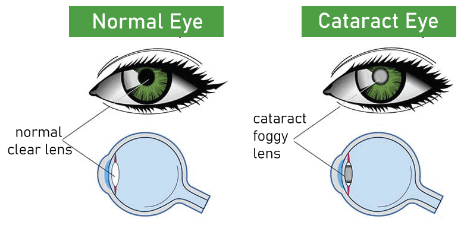Cataracts DefinitionMost cataracts develop as we age, typically beyond the age of 40. Although they frequently damage both eyes, cataracts might occasionally affect one. The eye's natural lens, located between the iris and the pupil, becomes clouded in a cataract. Cataracts, which may be removed, are the most frequent cause of eyesight loss worldwide. 
What triggers a cataract?Cataracts are the aggregates that are responsible for cloudiness. The proteins that make up the eye's natural lens might clump together as we age. It could get more difficult to notice as they enlarge and cover more of the lens over time. Like a camera lens, the lens inside the eye focuses light onto the retina to provide sharp vision. Moreover, it modifies the eye's focus, enabling us to view objects up close and far away. The majority of the eye's lens is made up of water and protein. The perfect arrangement of the protein maintains the lens' clarity and permits light to pass through it. Symptoms of cataractThe initial stages of a cataract don't significantly impair your vision. It may take months or years for visual symptoms to become apparent. You might detect a slight blurring of your vision as if you were peering through the hazy glass. Each eye's cataract development may proceed differently, leaving one eye with visual complaints and the other with normal vision. Moreover, you might experience the following signs of cataracts:
An advanced cataract can make the pupil appear light grey to onlookers rather than black. The specific symptoms you encounter, and their timing will depend on the type of cataract you have. See an eye doctor for an examination if you suspect you may have a cataract to confirm it. Various types of cataractsThere are many types of cataracts, but some are far more prevalent than others.
Treatment of cataractsWhen symptoms start, you might be able to temporarily improve your vision by using:
Cataract surgery is one of the other possible treatments for advanced cataracts. Your eye doctor may advise surgery if your quality of life is beginning to be negatively impacted by cataracts. This is typically considered a safe and efficient approach to regaining your vision. Many people believe that declining vision is an unavoidable part of aging, yet cataract surgery is a quick and relatively painless way to restore vision. Restoring vision after cataract surgery is very successful. According to Prevent Blindness, more than 2 million Americans have cataract surgery each year, making it the most common surgical procedure in the country. Detection of cataractsEye physicians can use several tests to identify cataracts.
Once diagnosed, cataracts don't always need to be treated, especially if they aren't troubling you. At first, a straightforward adjustment to your eyeglass prescription can be enough to improve your vision. Reduction of cataractsThere is currently no known way to prevent cataracts from forming. However, reducing any of the risk factors mentioned above might lessen the rate at which they advance. Some strategies for reducing cataract risk factors include:
Next TopicCell Definition
|
 For Videos Join Our Youtube Channel: Join Now
For Videos Join Our Youtube Channel: Join Now
Feedback
- Send your Feedback to [email protected]
Help Others, Please Share










